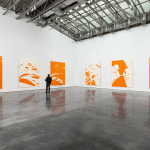
Contributed by Saul Ostrow / Given the complexity of Jeremy Gilbert-Rolfe’s work and his critical and theoretical writings, this is less a review of his present show at David Richard Gallery than it is an analysis of the critical position that they may represent. Over the years I have written several reviews of his work focusing on his restructuring of formalism, in which he has waived the reductive purism and essentialism often associated with that term. He has subtly set aside other received truths about abstract art. He engages abstract painting as a philosophical subject consisting of things which, regardless of differences of form and content, have been assigned the same classification. This might be rooted in Austrian philosopher Ludwig Wittgenstein’s observation that the members of a category are not identical to one another but share family resemblances. One corollary is that there is no such thing as abstract painting but only those practices that constitute a technology or body of knowledge that guide its production.

Gilbert-Rolfe approaches the practices of abstract painting as an array of constellations that are dialectically bound together. He wanders among these differing configurations, determining what he may use, discard, or recycle, and what must be invented anew. He does this not in any systematic manner but rather in an intuitive one, thereby bridging the gap between modernist authenticity and post-modernist artifice. Rather than make some false claim based on art history’s misrepresentation of abstract painting as a specific type of thing, or formalist discourse, Gilbert-Rolfe has chosen to make paintings that disassemble as viewers engage with them.

Like Robert Ryman and Frank Stella, Gilbert-Rolfe understands that an abstract painting consists of differing factual events, some that remain random and others that come together coherently. Unlike a sign, their sense corresponds to their particular attributes. Each painting manifests differing situations and conditions that it makes perceptible. Central to deciphering Gilbert-Rolfe’s practice, therefore, is the proposition that an abstract painting’s identity lies in its materialization such that its effects cannot be imagined, represented, or actualized by other means of notation, including photography or text. In this sense, his abstract paintings are real, and not simulacra of other things. This preserves something of the repressed phenomenological aesthetic of late-1960s post-Minimalism, with which his work was initially identified.

Among the myriad possible combinations of attributes that make up abstract painting, those in Gilbert-Rolfe’s work consist of mismatched geometric shapes and grids, linear elements, hard-edge forms, gestural passages, saturated colors and diffused grounds – marks, strokes, and smears configured to stimulate an intuited experience of form, space, and process. Each painting is distinguished by its own visual logic, lapses of reason, improvisation, intended irregularities, and conformity with or departure aesthetic norms. To an impatient viewer who wants to know what Gilbert-Rolfe’s works are “about,” they may appear to be mere variants on a historical model. But they are intended to revise or subvert it.

For Gilbert-Rolfe, abstract painting serves as an allegory for how the material world is inevitably a cognitively incomplete assemblage of visual and aesthetic propositions. It follows that his paintings are meditations on the heterogeneous and indeterminate nature of post-historical “self-hood.” But things do not end there. His practice also advances the existential notion that a thing’s identity is unstable and can never be completely captured. Paradoxically, its identifiable particulars remain essential to its being.


Jeremy Gilbert-Rolfe, “Paintings from 2009 to 2022,” David Richard Gallery, 211 E. 121st Street, New York, NY. Through June 17, 2022.
About the author: Saul Ostrow is an independent curator and critic. Since 1985, he has organized over 80 exhibitions in the US and abroad. His writings have appeared in art magazines, journals, catalogues, and books in the USA and Europe. In 2010, he co-founded (with David Goodman and Edouard Prulehiere) the not-for-profit Critical Practices Inc. as a platform for critical conversation and cultural practices. He has also served as Art Editor at Bomb Magazine, Co-Editor of Lusitania Press, and Editor of the book series Critical Voices in Art, Theory and Culture published by Routledge. A collection of his essays, Formal Matters, will be published by Elective Affinities next fall.























Gilbert-Rolfe’s paintings have an interesting vocabulary that touch on the works of many abstract pioneers such as Mondrian and Helen Frankenthaler. Putting aside the theories of Wittgenstein and Greenberg and Fried and what exactly is progress in abstract painting? It’s not exactly fashionable these days to wax eloquent on philosophy of being when artists have so many different stories to tell about themselves and their bodies. The author writes and communicates well but the language is difficult especially without that guide to the art market looking glass- Artforum. The language is not very important everyone speaks from the same sources.
Jeremy’s show is pure pleasure; both visual and intellectual. It’s simulating; fresh and speaks to the joy of painting. It’s the kind of work that opens doors. Saul’s review intelligently puts it into both an historical and philosophic context that most helpfully sets it beyond my “gee, wow!” response. Thank you!